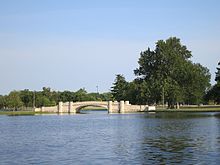Fairground Park
| Fairground Park | |
|---|---|
 Fairground Park lake bridge | |
 | |
| Type | Urban park |
| Location | St. Louis, Missouri, United States |
| Coordinates | 38°39′56″N 90°13′18″W / 38.6656°N 90.2217°WCoordinates: 38°39′56″N 90°13′18″W / 38.6656°N 90.2217°W |
| Area | 131 acres (53 ha) |
| Created | 1908 (as fairgrounds 1856) |
| Operated by | St. Louis Department of Parks, Recreation, and Forestry |
| Status | Open |
| Website | stlouis-mo.gov |
Fairground Park is a municipal park that opened in 1908 in St. Louis, Missouri. It was originally a privately owned facility, first used by the St. Louis Agricultural and Mechanical Association for the St. Louis Exposition from 1856 through 1902. However, the Civil War interrupted the annual fair when the Fairgrounds were used as a Union encampment known as Benton Barracks.[1][2] The annual exposition ceased in 1902 as preparations for the 1904 World's Fair began.[3]
History[]
Fair Grounds Race Track[]

The Fairgrounds originated in 1856 with the St. Louis Agricultural and Mechanical Association. In the early 1880s, the association fell upon hard times and was replaced with the St. Louis Fair and Jockey Club.[2]
In 1901, Cap Tilles, , and Louis A. Cella, the principal owners of , purchased the St. Louis Fairgrounds.[2] Since 1892, the partnership had been purchasing race tracks across the St. Louis area, with Delmar Track becoming the main competitor to the St. Louis Fair and Jockey Club. By the turn of the century, the competition won out, with Tilles becoming President of the new association.[4]
However, the revival of the Fairgrounds suffered another blow with the abolition of gambling on horse racing in Missouri in June 1905.[5][6] Governor Joseph W. Folk was elected in 1904, running as an anti-gambling, progressive reformer.[7] Folk signed the Anti-Breeders Act, directly leading to the permanent closure of the St. Louis Fairground Track.

In 1908, after protracted political debate, the abandoned 132-acre (0.53 km2) fairground was purchased from the association for park use by St. Louis for $700,000. The park was dedicated on October 9, 1909.[8]
All of the former fair structures and zoo buildings were removed except the bear pits of the old zoo and the amphitheater. In 1912, the amphitheater was removed and replaced by the city's first municipal swimming pool, then said to be the world's largest.[9] It was at this pool that Fairground Park riot occurred, which was a race riot that occurred in 1949 when the pool integrated African-Americans with Caucasian-Americans. The original pool was replaced by a new pool in 1958 as part of the 1955 bond issue program,[10] which also provided lighted ball diamonds and hardsurface tennis courts.
At the corner of Grand Boulevard and Natural Bridge Avenue, the facade of the old bear pits still stands at the park's main entrance.
Geography[]

Fairground Park is located in North St. Louis. It is bordered by Grand Boulevard to the east, on the south, to the west, and Kossuth Street to the north.
Surrounding areas[]
The park is surrounded by four neighborhoods. They are Fairground to the northeast, O'Fallon to the northwest, Greater Ville to the southwest, and Vandeventer to the southeast.
See also[]
- Neighborhoods of St. Louis
- Parks in St. Louis, Missouri
- People and culture of St. Louis, Missouri
- St. Louis Exposition
- Vearne C. Babcock
References[]
- ^ Williams, Scott K. "Benton Barracks, Missouri". Archived from the original on November 3, 2012. Retrieved December 21, 2012.
- ^ Jump up to: a b c St. Louis Republic. "Fair Grounds to be Sold to Syndicate", March 15, 1901, Front Page. Retrieved Dec. 8, 2013.
- ^ "St. Louis Parks-Fairground Park". City of St. Louis. Retrieved December 21, 2012.
- ^ Carver 2002, p. 178.
- ^ The New York Times. "Folk Offers Soldiers To Stop Track Betting", June 19, 1905, p. 2. Retrieved Dec. 8, 2013.
- ^ The Washington Post. "Delmar Races Under New Law", March 18, 1901, p. 4. Retrieved Dec. 8, 2013.
- ^ Carver 2002, p. 179.
- ^ "Fairground Park - City of St. Louis Parks". City of St. Louis, MO: Official Website. Retrieved 4 March 2018.
- ^ Blake, John (March 6, 2021). "A drained swimming pool shows how racism harms White people, too". CNN. Retrieved 2021-03-07.
- ^ University of Missouri—St. Louis. "St. Louis Bond Issue 1955 Voting Totals Election of May 26, 1955 (Special Election)". League of Women Voters Collection, Western Historic Manuscripts. Retrieved Dec. 8, 2013.
Bibliography[]
- Carver, Nancy Ellen. Talk with Tilles: Selling Life in Fort Smith, Arkansas. St. Louis: Xlibris Publishing, October 21, 2002.[self-published source?]
External links[]
- What Remains of Fairgrounds Park - Fairground Park - What Remains Today
- Parks in St. Louis
- Culture of St. Louis
- Tourist attractions in St. Louis
- 1908 establishments in Missouri
- Protected areas established in 1908
